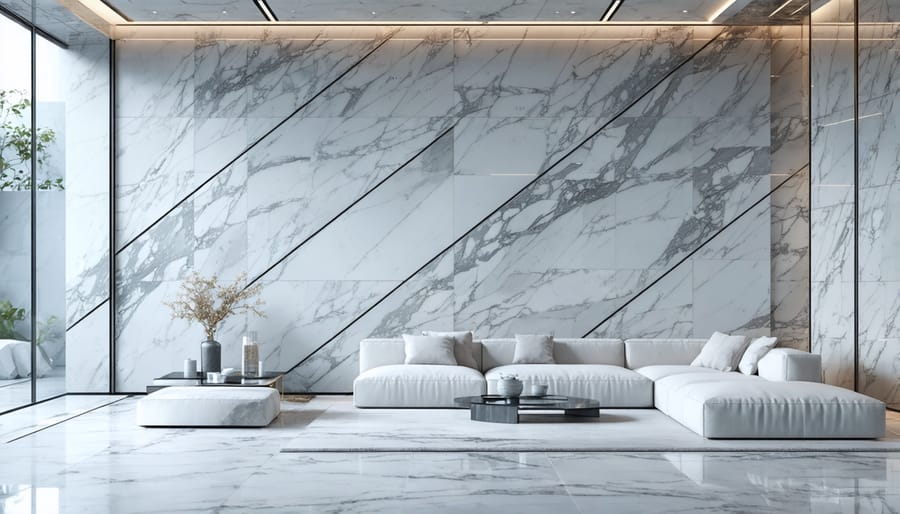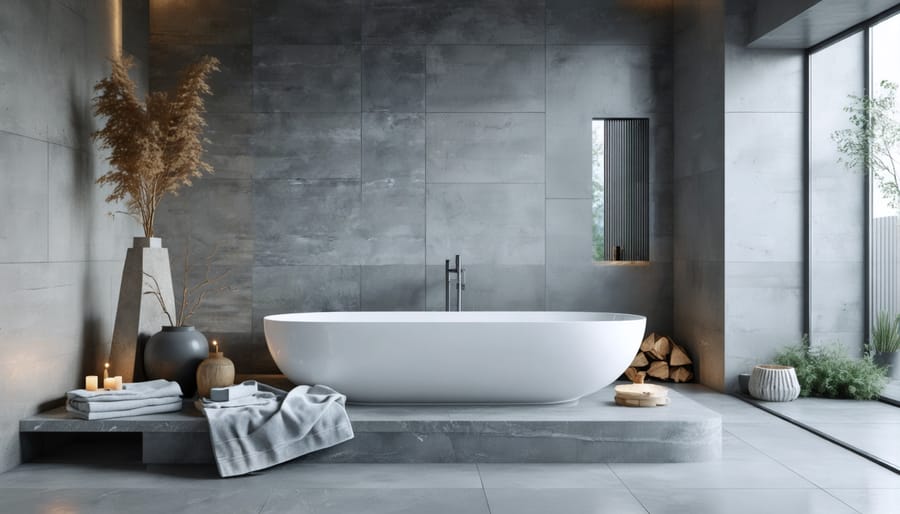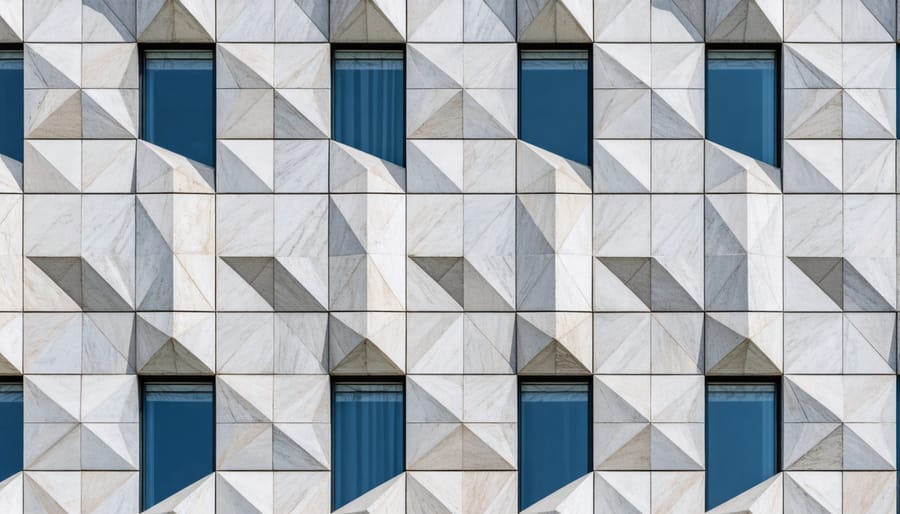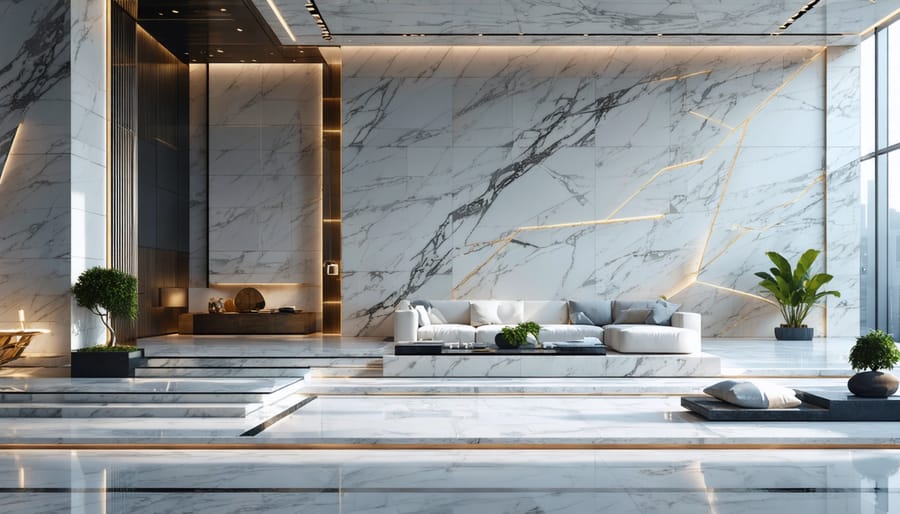Geometric minimalism strips architecture down to its purest forms, creating spaces where natural stone materials intersect with clean lines and precise angles. This design philosophy transforms ordinary spaces into powerful statements of restraint and intention, where every element serves both form and function. By emphasizing fundamental shapes—squares, circles, and triangles—alongside monochromatic palettes and uncluttered surfaces, geometric minimalism achieves a timeless aesthetic that resonates across residential and commercial applications.
Modern architects and designers harness this approach to create environments that feel simultaneously bold and serene, using careful material selection and thoughtful spatial relationships to maximize impact while minimizing visual noise. The result is architecture that speaks through simplicity, where each carefully chosen element contributes to a cohesive whole that’s greater than the sum of its parts. This strategic reduction of design elements to their essential forms doesn’t just create visually striking spaces—it fosters environments that promote clarity of thought and purpose, making geometric minimalism as functional as it is beautiful.
The Philosophy of Geometric Minimalism in Stone
Core Design Principles
The essence of geometric minimalism lies in its dedication to pure, elemental forms and precise execution in stone applications. This design philosophy emphasizes three fundamental principles: clean lines, basic geometric shapes, and mathematical precision. Clean lines create clear boundaries and transitions, allowing the natural beauty of stone to speak without unnecessary embellishment. Basic shapes like squares, rectangles, and circles serve as the building blocks of minimalist design, creating a sense of order and visual harmony.
Mathematical precision plays a crucial role in achieving the desired aesthetic impact. Perfect angles, consistent spacing, and precise measurements ensure that each stone element relates harmoniously to the whole composition. This exactitude extends to joint widths, pattern repetition, and surface alignment. The interplay between these elements creates a sophisticated simplicity that characterizes successful geometric minimalist designs.
The key to mastering these principles lies in thoughtful material selection and meticulous installation techniques. When properly executed, these fundamentals create spaces that feel both contemporary and timeless, striking the perfect balance between bold architectural statement and understated elegance.
The Monochromatic Appeal
The power of monochromatic design in geometric minimalism lies in its ability to create visual harmony while emphasizing form and texture. When working with natural stone, limiting the color palette to a single hue or subtle variations within the same color family allows the material’s inherent characteristics to take center stage. This approach creates a sense of calm and sophistication, making spaces appear larger and more cohesive.
In spaces where light-colored stones like Carrara marble or cream limestone dominate, shadows and geometric patterns become more pronounced, creating subtle depth and visual interest. Dark monochromatic schemes using materials like absolute black granite or slate can establish a dramatic, contemporary atmosphere while maintaining the clean lines essential to minimalist design.
The monochromatic approach also simplifies decision-making in design implementation. By focusing on a single color, designers and architects can direct attention to the interplay of geometric shapes, surface finishes, and spatial relationships. This strategy proves particularly effective in commercial spaces where brand consistency is paramount, or in residential settings where a serene, uncluttered environment is desired.
When executing monochromatic designs, varying the texture and finish of stone surfaces – from honed to polished, bush-hammered to flamed – adds complexity without compromising the minimalist aesthetic. This thoughtful manipulation of surface treatments creates visual depth while maintaining the purity of the single-color scheme.
Implementing Geometric Patterns in Stone
Material Selection
In geometric minimalism, material selection plays a pivotal role in achieving the desired aesthetic impact. White marble, with its clean appearance and subtle veining, remains a top choice for minimalist designs, offering a perfect canvas for geometric patterns. Absolute Black granite provides striking contrast and delivers sharp, precise edges essential for geometric formations.
For larger installations, limestone and travertine present excellent options due to their consistent coloring and texture. These materials work particularly well in monochromatic schemes where subtle variations create depth without overwhelming the space. Quartzite offers durability while maintaining visual simplicity, making it ideal for high-traffic areas requiring both form and function.
When selecting materials, consider their finish as well. Honed surfaces align better with minimalist principles than polished ones, as they create less visual distraction and maintain focus on the geometric forms. Brushed or leathered finishes can add subtle texture while preserving the clean aesthetic.
For optimal results, limit your palette to two or three stone types maximum. This restriction helps maintain visual clarity and emphasizes the geometric patterns. Consider the stone’s natural characteristics – how it cuts, its dimensional stability, and how it responds to different finishing techniques. These factors significantly impact the final execution of your minimalist design.
Remember that successful geometric minimalism often relies more on the quality of the chosen materials than their quantity or variety. Select stones that can be cut precisely and maintain their edges, ensuring clean lines and exact angles in the final installation.
Pattern Creation
Creating geometric patterns with natural stone requires careful planning and precise execution. The process begins with selecting stones of consistent size and thickness, ensuring uniformity in the final design. For maximum visual impact, consider using contrasting stone varieties, such as pairing light marble with dark granite, or combining different finishes of the same stone type.
The foundation of geometric pattern creation lies in basic shapes: squares, rectangles, triangles, and hexagons. These elements can be arranged in various configurations to create striking visual effects. Popular patterns include herringbone, basketweave, and chevron designs, each offering different levels of complexity and visual interest.
Modern cutting techniques allow for precise stone fabrication, enabling complex pattern creation with minimal grout lines. Computer-aided design (CAD) software helps visualize patterns before installation, ensuring perfect alignment and symmetry. For large-scale installations, it’s essential to create a detailed layout plan that accounts for natural stone variations and pattern repetition.
When implementing geometric patterns, consider the scale of the space and viewing distance. Larger spaces can accommodate bold, oversized patterns, while smaller areas benefit from more subtle, refined designs. The pattern should complement the room’s architecture and maintain visual harmony with other design elements.
For successful installation, use precision-cut templates and maintain consistent joint widths. This attention to detail ensures clean lines and professional results that exemplify geometric minimalism’s core principles.

Surface Finishes
In geometric minimalism, surface finishes play a crucial role in achieving the desired aesthetic impact. The interplay between different stone finishes can dramatically affect how light interacts with geometric forms, creating varying degrees of visual interest while maintaining minimalist principles.
Polished finishes offer a mirror-like reflective surface that emphasizes the stone’s natural patterns and colors. This high-gloss finish creates striking contrasts in minimalist designs, particularly effective in spaces where light plays a significant role. However, for more subdued applications, honed finishes provide a smooth, matte appearance that reduces glare while preserving the stone’s natural beauty.
Leathered and brushed finishes introduce subtle texture without compromising minimalist principles. These finishes maintain the stone’s natural color while adding tactile interest, perfect for creating depth in monochromatic schemes. For exterior applications or areas requiring additional grip, flamed finishes offer practical benefits while contributing to the overall geometric aesthetic.
The selection of finish should complement the stone’s intended purpose and surrounding elements. In contemporary minimalist designs, combining different finishes can create subtle transitions between spaces or emphasize specific architectural features. For example, pairing honed flooring with polished wall panels can define distinct zones while maintaining visual cohesion.
When implementing multiple finishes, consider how they interact with natural and artificial lighting throughout the day, as this can significantly impact the overall spatial experience.
Popular Applications
Interior Spaces
Interior spaces offer endless possibilities for expressing geometric minimalism through natural stone applications. Floors serve as the foundation, where large-format stone tiles arranged in precise grid patterns create a sense of spacious simplicity. Popular choices include honed limestone or basalt in monochromatic tones, installed with minimal grout lines to maintain visual continuity.
Walls become dramatic canvases for geometric expression, whether through book-matched marble panels creating symmetrical patterns or three-dimensional stone tile arrangements that play with light and shadow. The careful placement of stone panels can emphasize horizontal or vertical lines, influencing the perceived dimensions of a space while maintaining minimalist principles.
Feature elements provide opportunities for bold geometric statements. Stone-clad columns with clean lines, cubic stone benches, or geometric fireplace surrounds serve as focal points without overwhelming the space. Modern interpretations often incorporate floating stone shelves or accent walls with precise angles and edges, demonstrating how minimalism doesn’t equate to monotony.
Successful geometric minimalism in interior spaces relies on thoughtful material selection and precise installation. The natural variations in stone textures add subtle depth while maintaining the overall minimalist aesthetic. Strategic lighting placement enhances these geometric forms, casting shadows that emphasize the intentional simplicity of the design.
When implementing geometric minimalism, consider the scale of the space and how different stone elements interact. The goal is to create a harmonious environment where each geometric element contributes to the overall composition without competing for attention.

Exterior Features
In exterior applications, geometric minimalism transforms ordinary building surfaces and landscapes into striking architectural statements. Modern facades featuring clean-cut stone panels arranged in precise grid patterns create powerful visual impact while maintaining simplicity. Large-format limestone or granite slabs, installed with minimal joint lines, deliver a seamless aesthetic that exemplifies minimalist principles.
Pathways and walkways benefit from geometric patterns that guide movement while complementing biophilic design elements. Rectangular pavers laid in running bond or stack bond patterns create linear progression, while offset arrangements add subtle visual interest without compromising minimalist ideals. The interplay between different stone finishes – honed, flamed, or bush-hammered – can define spaces without introducing complex patterns.
Landscape elements particularly shine when geometric minimalism is applied thoughtfully. Cubic stone planters, linear water features, and precisely cut retaining walls become architectural focal points. The strategic placement of these elements creates rhythm and balance in outdoor spaces. Popular applications include floating stone steps over water features, geometric stone benches, and modular garden walls that incorporate right angles and clean lines.
The success of exterior geometric minimalism often lies in material selection. Stones with consistent coloring and minimal veining, such as bluestone or basalt, maintain visual clarity. When combined with proper lighting design, these elements cast dramatic shadows that enhance architectural features while preserving the minimalist aesthetic throughout day and night.

Maintenance and Longevity
Maintaining the pristine appearance of geometric minimalist stone designs requires a thoughtful approach to both regular care and long-term preservation. The key to sustaining these clean, modern aesthetics lies in understanding how natural stone interacts with its environment while connecting with nature in an intentional way.
Start with a protective sealing process immediately after installation, particularly for porous stones like limestone or marble. This initial treatment creates a barrier against stains and environmental factors while preserving the stone’s natural beauty. Reapply sealant every 12-24 months, depending on the stone type and exposure levels.
Daily maintenance should focus on gentle cleaning methods. Use pH-neutral cleaners specifically formulated for natural stone, avoiding acidic or abrasive products that can damage the surface. Regular dusting and wiping with a soft microfiber cloth prevents buildup that could compromise the minimalist aesthetic.
For outdoor geometric installations, consider seasonal maintenance schedules. Spring and fall are ideal times for deep cleaning and inspection. Watch for signs of weathering, particularly in regions with extreme temperature fluctuations. Address any chips or cracks promptly to prevent further deterioration.
Professional maintenance every few years can help preserve the precise lines and angles essential to geometric minimalism. This might include restoration processes like honing or polishing to maintain the desired finish and geometric precision. Keep detailed records of treatments and maintenance schedules to ensure consistent care.
Temperature control and humidity management play crucial roles in indoor installations. Maintain stable environmental conditions to prevent thermal shock and moisture-related issues. Use appropriate backing materials and expansion joints in large installations to accommodate natural stone movement while preserving geometric patterns.
Geometric minimalism in stone design continues to captivate designers, architects, and homeowners alike, proving its enduring relevance in contemporary spaces. The marriage of natural stone’s organic beauty with clean, precise geometric forms creates a powerful visual statement that transcends passing trends. This design approach’s lasting appeal lies in its ability to achieve sophistication through simplicity, allowing the inherent characteristics of stone to shine while maintaining a structured, purposeful aesthetic. Whether expressed through angular countertops, linear wall cladding, or modular flooring patterns, geometric minimalism offers a timeless solution that brings both order and serenity to modern interiors. As we continue to seek balance between nature and design, this elegant approach remains a cornerstone of contemporary architecture, promising to inspire future generations of designers and stone artisans.










